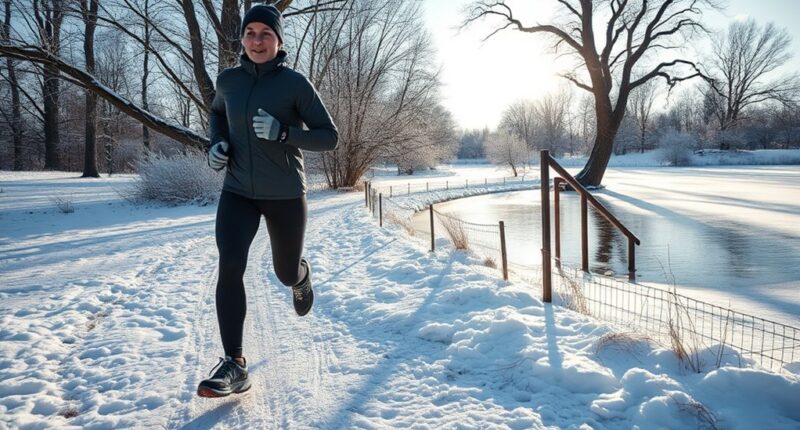When you run in cold weather, your body responds by constricting blood flow to your extremities like fingers and toes to preserve core temperature, which can make them feel numb. Muscles tighten and become less flexible, increasing injury risk, but a proper warm-up can help. Cold air may irritate your lungs, so covering your face is smart. Understanding these changes helps you stay safe and perform better—keep going to learn more about how your body reacts.
Key Takeaways
- Blood vessels constrict in extremities to preserve core temperature, causing coldness and numbness in fingers, toes, and ears.
- Muscles tighten in cold weather, increasing injury risk, but warming up improves flexibility and reduces strains.
- Cold air can irritate airways; wearing face protection helps warm inhaled air and eases breathing.
- Proper layered gear traps heat, maintains performance, and reduces heat loss during outdoor runs.
- Cold increases physical effort, leading to quicker fatigue and necessitating additional warm-up and hydration.

Running in cold weather can be challenging, but with the right preparation, you can stay safe and enjoy your workouts year-round. When the temperature drops, your body responds in ways that help preserve warmth and maintain function, but those responses can also impact your performance and comfort if you’re not prepared. To keep your body functioning at its best, investing in proper winter gear is essential. Layering moisture-wicking base layers with insulating mid-layers and windproof outer shells helps trap heat and protect you from the elements. Don’t forget to use hand warmers—small but effective tools that keep your extremities warm during cold runs. Hand warmers can make a significant difference, especially when your hands tend to get cold quickly, impairing your grip and dexterity. Wearing thermal gloves and using hand warmers together ensures your hands stay warm, which is indispensable for maintaining a good grip on water bottles or your phone.
When you step outside into chilly air, your body immediately starts working to keep your core temperature stable. Blood vessels in your skin constrict, reducing blood flow to your extremities to conserve heat and prioritize essential organs. This process, called vasoconstriction, can cause your fingers, toes, nose, and ears to feel cold or numb. As a result, you might notice reduced dexterity or even pain in these areas. To combat this, you should wear insulated gloves, thermal socks, and a warm hat—since a lot of heat escapes through your head. Layering appropriately and using winter gear ensures your body can focus on delivering blood efficiently to your muscles, enabling you to run more comfortably. Additionally, understanding body’s thermoregulation helps you better prepare for varying cold conditions and maintain optimal performance.
Your muscles also respond to cold by tightening up, which can increase injury risk. Warm muscles are more flexible and less prone to strains. That’s why a proper warm-up is indispensable before heading out. A brisk walk or light jog followed by dynamic stretches will raise your core temperature and loosen your muscles. During your run, your body works harder to generate heat, which can lead to increased fatigue if you’re not dressed properly. Hydration remains important, even in cold weather, although you might not feel as thirsty. Your respiratory system also reacts; cold air can irritate your lungs and airway, especially if you have respiratory issues. Wearing a buff or face mask can help warm the air before it hits your lungs, easing breathing and protecting your airways.
Frequently Asked Questions
How Does Cold Weather Affect Muscle Flexibility During Runs?
Cold weather causes your muscles to become stiffer, leading to a reduction in flexibility during your runs. As temperatures drop, your muscles contract and lose elasticity, making it harder to move freely. This stiffness increases the risk of strains and injuries if you don’t warm up properly. To counteract this, make sure to do dynamic stretches before running and wear appropriate gear to keep your muscles warm and flexible.
Can Cold Temperatures Impact Hydration Needs While Running?
Yes, cold temperatures can impact your hydration needs while running. You might not feel as thirsty, but you still lose fluids through sweat and respiration. To stay properly hydrated, use effective hydration strategies and pay attention to your electrolyte balance, especially in colder weather. Drinking water regularly and including electrolytes in your drinks help prevent dehydration and maintain performance, even when it’s chilly outside.
What Are the Risks of Frostbite During Winter Running?
Frostbite can sneak up on you if you’re not careful, especially in biting wind and freezing temps. The risk factors include exposed skin, inadequate clothing, and high wind chill. To prevent this, layer properly, cover all skin, and stay dry. Keep an eye on your extremities, and don’t ignore signs of numbness. With these prevention strategies, you’ll stay safe and enjoy your run without icy surprises.
Does Cold Weather Influence Heart Rate and Exertion Levels?
Cold weather can increase your heart rate variability and heighten your exertion perception. As you run in the cold, your body works harder to stay warm, which may make you feel like you’re exerting more effort even if your heart rate doesn’t spike markedly. You might notice your breathing becomes more labored, and your perceived exertion increases, so it’s essential to listen to your body and adjust pace accordingly.
How Does Cold Air Impact Lung Function During Exercise?
When you run in cold air, your lungs feel the pinch first. Cold temperatures cause airway constriction, making it harder to breathe and increasing your respiratory rate. You might notice your chest tightening or coughing more. Cold air can irritate your airways, so you need to take it slow and breathe through your nose. Remember, a little patience goes a long way when your lungs are working overtime.
Conclusion
As you brave the chilly air, remember your body is like a well-tuned engine, adapting to the cold with each stride. Your muscles warm up, your heart works harder, and your breath forms icy clouds. Embrace the cold-weather run as a invigorating challenge that sharpens your resilience. With every step, you’re forging strength in the frost—turning winter’s icy grip into a powerful motivator. Keep moving forward, and let the cold fuel your fire to push further.








